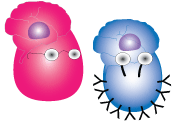
Escaping negative selection
Although negative selection is very stringent and the vast majority of developing auto-reactive lymphocytes die by apoptosis in the primary lymphoid organs, some self-reactive B and T cells escape into the circulation. One reason for this may be that not all self-antigens are available in the primary lymphoid organs for lymphocytes to be tested against.
Remember the T cell development video on the previous page. Did you notice that there were many different cell types in the thymus that were presenting self-peptide:MHC molecules for the TCR to be tested on? Even with this variety, it is impossible to display the entire repertoire of peptides derived from every protein made in the body which mature T cells may encounter in the body. Some peptides might not be expressed until a certain period during your life, like proteins associated with pregnancy. Other mechanisms are therefore required to make sure that these auto-reactive T cells that escape negative selection do not go wild when they find their specific target self-peptide. One such solution is the natural regulatory T cells, or nTregs, which are characterised by their expression of a transcription factor called forkhead box P3 (Foxp-3). nTregs develop because some thymocytes that bind self-peptide:MHC complexes with intermediate affinity are not deleted by negative selection but are instead allowed to live and develop into a regulatory T cell subtype which is released into the circulation. If these nTregs come across auto-reactive T cells in the tissues they are able to stop them from attacking self by switching them to an unresponsive mode called anergy. How the nTregs make the auto-reactive T cell anergic will be covered later on. Scientists have some evidence that a similar regulatory B cell population may exist.
To summarise the past two pages, the majority of B and T cells that reach maturity and are released out into the circulation are specific for non-self antigens, however, some self-reactive lymphocytes also find their way out into the body along with some regulatory lymphocytes. None of these cells have so far encountered their specific antigen and are therefore said to be naive. On the next page we will see what these cells could face as their life progresses in the body.